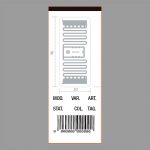UHF RFID tags are characterized by various types of memory that are used for different purposes and functionalities.
Each UHF Gen2 tag is equipped with an antenna and an IC (Integrated Circuit) containing four types of memory:
- Reserved memory
- EPC memory
- TID memory
- User memory
Depending on the type of chip (IC) chosen for your project, you can leverage different memory sizes and functionalities. Let’s explore them in more detail.
Reserved memory This memory bank stores two types of passwords: the “kill password” and the “access password,” both consisting of 32 bits. The “kill password” is used to permanently disable the tag, although it is rarely used. The “access password” is employed to lock or unlock the tag’s write functions. This memory bank can be programmed only if you want to specify one of these passwords. Typically, most users do not access this memory area unless their applications contain sensitive data. It’s essential to note that this memory bank can store only the two mentioned types of codes and cannot retain other information.
EPC memory This memory bank holds the EPC (Electronic Product Code) or electronic product code, with a minimum capacity of 96 writable bits. Usually, EPC memory is sufficient for most applications requiring only 96 bits of storage space. However, some tags have the capability to allocate additional bits from user memory to EPC memory. Therefore, EPC memory serves as the first writable memory block at your disposal.
TID memory This memory serves the sole purpose of storing the unique identification number of the tag, provided by the manufacturer during the production of the IC (Integrated Circuit). Typically, this portion of memory is immutable and cannot be modified.
User memory If the user requires more memory than what is available in the EPC section, some integrated circuits offer extended user memory capable of storing additional information. Regarding user memory, there is no standard for the number of writable bits on each tag. Usually, extended memory does not exceed 512 bits, but there are some advanced memory tag variants that can go up to 4K or 8K bytes of memory. This represents the second writable memory option available for Gen 2 integrated circuits.
In conclusion, we have examined in detail the various types of memory present in UHF RFID chips and their applications. We have seen how EPC memory is primarily used for the unique identification of tags, while extended user memory offers greater versatility for storing additional data. There is no strict standard for the amount of memory available in tags, but the trend is towards increasing memory capacity, with tags capable of reaching 4K or 8K bytes of storage. The choice of memory type depends on the specific requirements of the application and the need to store additional information. Overall, the evolution of memory capacities in UHF RFID chips is significantly contributing to the growth and effectiveness of these technologies in the fields of traceability and resource management.
Mecstar SRL offers a wide range of products and chips for UHF RFID technology. Our experts can guide you in selecting the right memory for your application.










